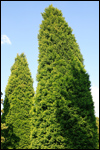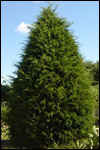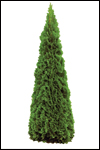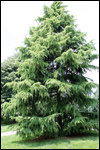Types of Mississippi Grown Christmas Trees
 • Leyland Cypress
• Leyland Cypress
(includes related crosses called Ovensii Cypress and Noble Cypress)
The Leyland cypress is a popular Christmas tree famous for its hardiness and longevity. If properly watered, these trees can last months. These trees generally have narrow crowns with branches from the base to the top of the tree. Foliage is medium green to blue-green, and the branches are long and compact, with dark red or red-brown offshoots. Because the branches are so flexible, hanging heavy ornaments may be difficult, though shearing can help. The Leyland cypress does not produce sap and has very little aroma, those with an allergy to sap can still enjoy a Mississippi Christmas tree.
 • Arizona Cypress
• Arizona Cypress
(includes varieties Carolina Sapphire and Blue Ice)
Arizona cypress trees have wide limbs at their bases, which creates a distinctive pyramid shape. The tree has dense blue-green or gray-green foliage and has a citrus scent. The bark is delicate and will often peel down the length of the tree. Although the Arizona cypress doesn’t last as long as the Leyland, it should last a full month if properly watered.
 • Eastern Redcedar
• Eastern Redcedar
(includes variety Burkii)
This species is famous for being the tree that southern families used for their Christmas trees before the advent of Christmas tree farms. The tree’s branches are close together; its foliage is dark, shiny green; and the bark is reddish brown. A properly planted and maintained Eastern redcedar will form a straighter trunk and denser foliage than the wild cedars once used as Christmas trees.
 • Virginia Pine
• Virginia Pine
Although this species is not native to Mississippi, Virginia pines are widely available across the state. The needles of this tree grow in pairs and are twisted together. The needles also are significantly shorter than most southern species of Christmas trees, at only 1½ to 3 inches long. The branches of Virginia pines are stout and sturdy enough for heavy ornaments. The trees can grow from 4 to 10 feet, and they have a fairly long lifespan after being cut if watered properly.
 • Arborvitae
• Arborvitae
(includes variety Green Giant)
The arborvitae is a sturdy tree, resistant to insects and disease. The Green Giant arborvitae is known for its conical, Christmas tree shape; it rarely requires any pruning. Its foliage is dark green and grows in flattened sprays, and it emits a sweet aroma when crushed. When kept in water, the tree keeps its needles quite well.
 • Deodar Cedar
• Deodar Cedar
The Deodar cedar is native to the Himalayas but is widely available in Mississippi. The tree has short, blue-green needles that can be prickly and tend to bunch together. The branches spread gracefully with a slight droop, depending on the age of the tree, and are sturdy enough for decorating. These trees retain their needles well only for a couple of weeks.
Sources: Dr. Stephen Dicke, Extension Professor, Central Mississippi Research & Extension Center, Mississippi State University; and LSU AgCenter materials developed by Extension Agents Keith Collins and Barton Joffrion.
